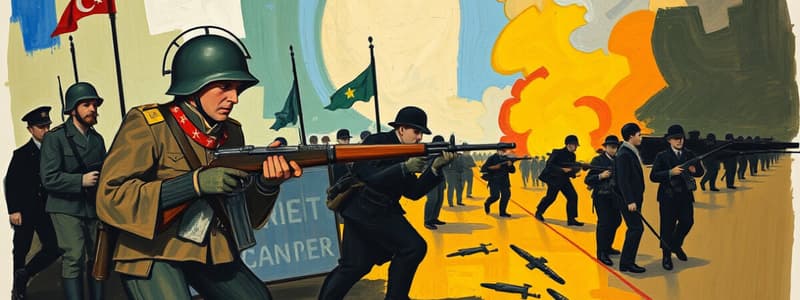Podcast
Questions and Answers
What was the period and duration of World War I?
What was the period and duration of World War I?
- 1914 to 1918; 4 years (correct)
- 1939 to 1945; 6 years
- 1914 to 1945; 31 years
- None of the above
What were some of the triggers and causes of World War I?
What were some of the triggers and causes of World War I?
- Harsh conditions of the Treaty of Versailles
- Assassination of Archduke Francis Ferdinand (correct)
- Militarism, Imperialism, Nationalism (correct)
- Political instability in Germany
The conflict in World War I was between the Central Powers and the _____ Powers.
The conflict in World War I was between the Central Powers and the _____ Powers.
Allied
The estimated casualties in World War II ranged from _____ to _____ million.
The estimated casualties in World War II ranged from _____ to _____ million.
What genocide was carried out by the Ottoman Empire?
What genocide was carried out by the Ottoman Empire?
What new methods of warfare were introduced during World War II?
What new methods of warfare were introduced during World War II?
What was one outcome of World War I?
What was one outcome of World War I?
World War II had the same countries participating as World War I.
World War II had the same countries participating as World War I.
The American president during World War I was _____ Wilson.
The American president during World War I was _____ Wilson.
Name a factor that contributed to the rise of Adolf Hitler in Germany.
Name a factor that contributed to the rise of Adolf Hitler in Germany.
What was a common nature of war in both World Wars?
What was a common nature of war in both World Wars?
Flashcards are hidden until you start studying
Study Notes
Period and Duration
- World War I lasted from 1914 to 1918, spanning 4 years.
- World War II lasted from 1939 to 1945, covering 6 years.
Triggers and Causes
- World War I was triggered by the assassination of Archduke Francis Ferdinand and fueled by militarism, imperialism, nationalism, and a complex alliance system.
- World War II stemmed from political and economic instability in Germany, harsh conditions imposed by the Treaty of Versailles, and the rise of Adolf Hitler. He formed alliances with Italy and Japan against the Soviet Union.
Conflict Between Powers
- In World War I, Central Powers included Germany, Austria-Hungary, and Turkey; Allied Powers were France, Britain, Russia, Italy, Japan, and the U.S. (from 1917).
- In World War II, Axis Powers were Germany, Italy, and Japan, while Allied Powers included France, Britain, the U.S., the Soviet Union, and China.
Casualties
- World War I resulted in approximately 10 million military deaths, 7 million civilian deaths, 21 million wounded, and 7.7 million missing or imprisoned.
- Estimated casualties in World War II exceeded 60 million, with total deaths ranging from 50 to 80 million. Civilian deaths ranged from 38 to 55 million, including 13 to 20 million from war-related diseases and famine.
Genocide
- World War I saw the Ottoman Empire commit genocide against Armenians.
- World War II witnessed the genocide by Nazi Germany against Jews and Romani people.
Methods of Warfare
- World War I involved trench warfare, reliant on artillery, machine guns, infantry assaults, tanks, early airplanes, and poison gas, characterized by limited mobility.
- World War II utilized nuclear weapons and missiles, modern covert operations, advanced submarine tactics, and the Blitzkrieg method by Germany.
Outcomes
- World War I led to the defeat of the German, Russian, Austro-Hungarian, and Ottoman empires, dissolving the latter two and establishing the League of Nations.
- World War II concluded with the Allies' total victory and the rise of the U.S. and Soviet Union as superpowers. The United Nations was founded to promote global cooperation.
Post-war Politics
- Distress from the Treaty of Versailles facilitated Adolf Hitler's rise in Germany, linking World War I to the causes of World War II.
- A Cold War emerged between the U.S. and the Soviet Union, resulting in proxy wars in places like Afghanistan, Vietnam, and Korea from 1947 to 1991.
Nature of War
- World War I was primarily a conflict for territorial acquisition, resources, and colonial dominance.
- World War II revolved around ideological warfare between Fascism and Communism.
American Presidents during the Wars
- Woodrow Wilson was the American president during World War I.
- Franklin D. Roosevelt (FDR) and Harry Truman were presidents during World War II.
Similarities in Combatant Countries
- Many countries participating in World War I also fought in World War II, though nations like Japan and Italy switched sides. Russia initially allied with Germany in World War II but changed loyalties after Germany invaded.
Innovation in Warfare
- Both wars focused on the importance of innovation in military technology, with some advancements, such as tanks, being improved from World War I to World War II.
Bacterial Infections and Combat Conditions
- Soldiers faced severe conditions in both conflicts, leading to significant bacterial infections and reduced living standards.
Combined Effects on the World
- Both World Wars had devastating global impacts, with Germany and Russia reporting around 30.8 million deaths combined across both conflicts.
Studying That Suits You
Use AI to generate personalized quizzes and flashcards to suit your learning preferences.




